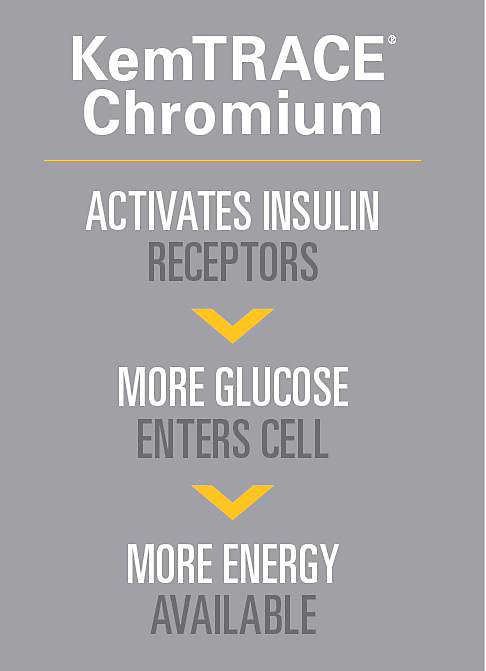You are viewing Canada
- United States
- Canada
- Mexico
- South America
- EMENA
- Sub-Saharan Africa
- Russia
- South Asia
- Asia Pacific
- China
- Global
Choose Your Location:
- United States
- Canada
- Mexico
Popular Searches
- Animal Nutrition & Health
- KemTRACE® Chromium
- KemTRACE® Chromium for Beef Cattle
KemTRACE® Chromium for Beef Cattle
Insulin is the Key
Insulin plays a key role in optimum cell function by acting as a "key" in the lock to the door that allows glucose into the cell. Once insulin has "unlocked the door," blood glucose can enter the cell and be used as an energy source. Chromium improves insulin function and results in efficient clearance of glucose from the bloodstream.1
Immune Function
Upon activation, immune cells become obligate glucose utilizers.2 Increased glucose uptake may help animals mount an immune response even under a severe immune challenge.

Increased Feed Efficiency
Chromium has been shown to alter insulin action and either increase dry matter intake or minimize a drop in feed intake among animals subjected to stress.3,4,5
Increased Protein Accretion
Insulin is the primary hormone responsible for the uptake and storage of glucose by insulin responsive tissues.6 Muscle and adipose tissue are the main insulin responsive tissues in ruminants, but muscle accounts for over 80 percent of the insulin-dependent uptake of glucose.7 Chromium acts to potentiate the action of insulin, increasing glucose availability within the cell.8 Additional glucose in the muscle cell provides the energy for optimizing protein synthesis resulting in improved live performance and increased hot carcass weight.9
Withstand the Effects of Stress
Chromium supplementation minimizes the negative effects of the stress response by consistently decreasing serum cortisol during stressful periods for cattle.10 During a stress event, such as an immune challenge, there can be substantial increases in glucose consumption by immune cells shifting energy demands away from production.11
Product Specifications
Resources

References
1Mertz, W. 1992. Chromium: History and nutritional importance. Biological Trace Element Research. 32:3-8.
2Palsson-McDermott E. M. and L. A. O’Neill. 2013. The Warburg effect then and now: From cancer to inflammatory diseases. Bioessays. 35:965-973.
3Alsaiady, M., M. Alshaikh, S. Al-Mufarrej, T. A. Al-Showeimi, H. H. Mogawer, and A. Dirrar. 2004. Effect of chelated chromium supplementation on lactation performance and blood parameters of Holstein cows under heat stress. Animal Feed Science and Technology. 117:223-233.
4An-Qiang, L., W. Zhi-Sheng, and Z. An-Guo. 2009. Effect of chromium picolinate supplementation on early lactation performance, rectal temperatures, respiration rates and plasma biochemical response of Holstein cows under heat stress. Pakistan Journal of Nutrition. 8.
5Vargas-Rodriguez, C. F., K. Yuan, E. C. Titgemeyer, L. K. Mamedova, K. E. Griswold, and B. J. Bradford. 2014. Effects of supplemental chromium propionate and rumen-protected amino acids on productivity, diet digestibility, and energy balance of peak-lactation dairy cattle. Journal of Dairy Science. 97:3815-3821.
6Weekes, T. E. 1991. Hormonal control of glucose metabolism. Proceedings of 7th International Symposium on Ruminant Physiology (ed. T. Tsuda, Y. Sasaki and R. Kawashima). 183.
7Kraegen, E. W., D. E. James, A. B. Jenkins, and D. J. Chisholm. 1985. Dose-responsive curves for in vivo insulin sensitivity in individual tissues in rats. American Journal of Physiology, Endocrinology and Metabolism. 248:E353-E362.
8Saltiel, A. R. and C. R. Kahn. 2001. Insulin signaling and the regulation of glucose and lipid metabolism.Nature. 414:799-806.
9Johnson, B., J. Baggerman, J. Kim, and Z. Smith. 2016. Chromium propionate enhances feedlot performance and carcass quality through changes in nutrient metabolism. Plains Nutrition Conference.
10Mowat, D. N. 1996. Supplemental organic chromium for beef and dairy cattle. Proceedings of Asia-Pacific Lecture Tour. 31.
11Stoakes, S. K., E. A. Nolan, D. J. Valko, M. Abuajamieh, M. V. Sanz Fernandez, and L. H. Baumgard. 2015. Estimating glucose requirements of an activated immune system in Holstein steers. Journal of Animal Science. 93:s3/Journal of Dairy Science. 98:s2.
Have a question?
If you have a question about our products or services, or just want more information, fill out the form below and someone on our team will be in contact with you.
- California Supply Chain Act
- Canada Forced Labor and Child Labor Report
- Email Disclaimer
- GDPR Personal Data Addendum
- General Terms & Conditions for Vendors
- Global Environmental Policy Statement
- Indirect Cost Estimates
- Kemin Terms & Conditions
- Modern Slavery Act Transparency Statement
- Privacy Policy
- Sitemap
- Change Cookie Consent
- Animal Welfare Statement
© Kemin Industries, Inc. and its group of companies All rights reserved. ® ™ Trademarks of Kemin Industries, Inc., USA
Certain statements may not be applicable in all geographical regions. Product labeling and associated claims may differ based upon government requirements.
